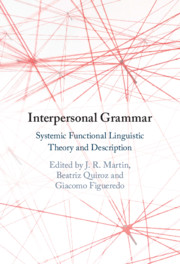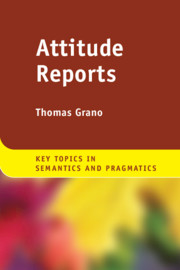Refine search
Actions for selected content:
6584 results in Grammar and Syntax
Bibliography
-
- Book:
- Attitude Reports
- Published online:
- 15 April 2021
- Print publication:
- 03 June 2021, pp 213-232
-
- Chapter
- Export citation
5 - De se Attitude Reports
-
- Book:
- Attitude Reports
- Published online:
- 15 April 2021
- Print publication:
- 03 June 2021, pp 122-153
-
- Chapter
- Export citation
2 - Foundations
-
- Book:
- Attitude Reports
- Published online:
- 15 April 2021
- Print publication:
- 03 June 2021, pp 15-65
-
- Chapter
- Export citation
7 - Other Topics
-
- Book:
- Attitude Reports
- Published online:
- 15 April 2021
- Print publication:
- 03 June 2021, pp 184-206
-
- Chapter
- Export citation
Acknowledgements
-
- Book:
- Attitude Reports
- Published online:
- 15 April 2021
- Print publication:
- 03 June 2021, pp xi-xii
-
- Chapter
- Export citation
List of Abbreviations Used in Glosses
-
- Book:
- Attitude Reports
- Published online:
- 15 April 2021
- Print publication:
- 03 June 2021, pp xiii-xiv
-
- Chapter
- Export citation
4 - The de dicto/de re Ambiguity
-
- Book:
- Attitude Reports
- Published online:
- 15 April 2021
- Print publication:
- 03 June 2021, pp 82-121
-
- Chapter
- Export citation
3 - Attitude Reports and Proper Names
-
- Book:
- Attitude Reports
- Published online:
- 15 April 2021
- Print publication:
- 03 June 2021, pp 66-81
-
- Chapter
- Export citation
Contents
-
- Book:
- Attitude Reports
- Published online:
- 15 April 2021
- Print publication:
- 03 June 2021, pp vii-x
-
- Chapter
- Export citation

The Grammar of Interactional Language
-
- Published online:
- 28 May 2021
- Print publication:
- 17 June 2021

Interpersonal Grammar
- Systemic Functional Linguistic Theory and Description
-
- Published online:
- 21 May 2021
- Print publication:
- 10 June 2021

Attitude Reports
-
- Published online:
- 15 April 2021
- Print publication:
- 03 June 2021
Abbreviations
-
- Book:
- The Languages of Mainland Southeast Asia
- Published online:
- 22 March 2021
- Print publication:
- 01 April 2021, pp xxiv-xxviii
-
- Chapter
- Export citation
Copyright page
-
- Book:
- The Languages of Mainland Southeast Asia
- Published online:
- 22 March 2021
- Print publication:
- 01 April 2021, pp iv-iv
-
- Chapter
- Export citation
2 - Language Histories and Classifications
-
- Book:
- The Languages of Mainland Southeast Asia
- Published online:
- 22 March 2021
- Print publication:
- 01 April 2021, pp 38-117
-
- Chapter
- Export citation
Note on the nature and organization of the book
-
- Book:
- The Languages of Mainland Southeast Asia
- Published online:
- 22 March 2021
- Print publication:
- 01 April 2021, pp xxii-xxiii
-
- Chapter
- Export citation
7 - Predication and Clausal Syntax
-
- Book:
- The Languages of Mainland Southeast Asia
- Published online:
- 22 March 2021
- Print publication:
- 01 April 2021, pp 326-392
-
- Chapter
- Export citation
Figures
-
- Book:
- The Languages of Mainland Southeast Asia
- Published online:
- 22 March 2021
- Print publication:
- 01 April 2021, pp ix-x
-
- Chapter
- Export citation
Maps
-
- Book:
- The Languages of Mainland Southeast Asia
- Published online:
- 22 March 2021
- Print publication:
- 01 April 2021, pp xi-xi
-
- Chapter
- Export citation
References
-
- Book:
- The Languages of Mainland Southeast Asia
- Published online:
- 22 March 2021
- Print publication:
- 01 April 2021, pp 396-428
-
- Chapter
- Export citation
